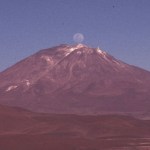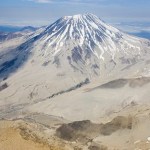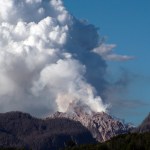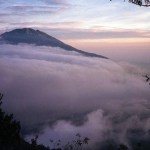
Alright, there has been some complaints that the last few MVPs have been too easy, so I tried to reach back and find one that might be more of a challenge for you all. Maybe this photo will do the trick ...
Current standings:
Don Crain - 2
volcanista - 1
Elizabeth - 1
Ralph - 1
gijs - 1
Anne - 1
Cam - 1
gg - 1
The Bobs - 1
Boris Behncke - 1
Good luck!
It seems like I've been stepping on a lot of people's toes lately, so in an effort to foster more camaraderie and less belligerence between the "old media" (this is not derogatory, but rather refers to anything pre-internet news source or classic journalistic source) and "new media" (this includes internet-era news sources, bloggers and the like), I'd like to put down my thoughts on the state of science journalism on the internet today.
I do not think all media is bad at science. There are a multitude of great science sources out there that handle the issues quite well, mostly associated…
Piton de la Fournaise erupting on November 5, 2009. Image by Julian Balboni in Clicanoo.
Eruptions reader Richard Oliver pointed out to me that Piton de la Fournaise on Reunion Island erupted (in french) on Thursday night. The volcano produced at least two lava flows that reached the ocean flowed downslope to ~1970 m above sea level, but by Friday morning, the seismicity and eruptive activity had waned considerably. Local residents of the island went out at night to see (in french) the lava flows, with the typical words of warning from local officials. The timeline for the eruption (in…
The latest of volcano news from around the world, brought to you by the USGS and Smithsonian Institute Global Volcanism Program (and especially Sally Kuhn Sennert!)
Highlights this week include:
Karangetang in Indonesia produced a couple 3 km/10,000 foot steam-and-ash plumes according to reports from pilots.
Soufriere Hills on the island on Montserrat has had quite a few pyroclastic flows over the last few weeks since the volcano started erupting again. Mix that with some heavy rainfall and lahars were produced as well.
The alert level is still at Orange at Karymsky in Kamchatka, which…
Lava flows from the 2005 Mando Hararo eruption in Ethiopia.
Alright, I had been attempting to ignore this story because it was, well, a little uninteresting at first, but it apparently has legs so I will tackle it.
Slashdot has a post proclaiming:
'Volcanic activity may split the African continent in two, creating a new ocean, say experts. This is due to a recent geological crack which has appeared in northeastern Ethiopia.'
OK. Where do I start?
This is based on a recent study published in Geophysical Research Lettersthat found that the recent volcanism in Ethiopia is related to the active…
You know, we haven't had an MVP in a couple weeks. Let's remedy that!
Current standings:
volcanista - 1
Elizabeth - 1
Ralph - 1
gijs - 1
Anne - 1
Cam - 1
gg - 1
The Bobs - 1
Boris Behncke - 1
Don Crain - 1
Here's MVP #11 ... good luck!
Just a reminder ...
Etna erupting in November 2002.
If you have any questions for Dr. Boris Behncke, who runs Italy's Volcanoes along with the volcanology page for the Italian National Institute of Geophysics and Volcanology in Catania, please send them in to me at
. I've got some good question so far!
There have been a number of articles floating around the popular press for the last week that I thought I would touch on briefly ... always fun to decipher the real news from the hype.
Active fumaroles on Datun Mountain in Taipei.
An article out of the Taipei Times suggests that the city of Taipei in Taiwan is in great peril from Datun Mountain/volcano. The volcano, which was previously thought to have erupted ~200,000 years ago is now thought to have erupted only 5,000 years ago. That 195,000 years really does make a difference in terms of worrying about potential future eruptions, but…
All the news to start the week:
Galeras with a grey ash-and-steam plume behind Pasto, Colombia.
Well, after my article on Friday about Colombian volcanoes, Galeras must have decided it was left out. The volcano has been placed back at alert level Orange/II (eruption in days to weeks). An increase in seismicity and sulfur dioxide emissions (in spanish) prompted INGEOMINAS to put Galeras back on higher alert, but now the country has two volcanoes (Galeras and Huila) that could be erupting in the near future.
Back in the Philippines, there is new evidence that Mayon has a new dome forming at…
There has been news over the last few days of a number of volcanoes in Colombia, so I thought I'd try to gather it up here:
The steaming summit of Nevado del Huila in Colombia
Nevado del Huila has been ramping up its ash emissions, potentially pointing towards new eruptions from the crater dome. The NASA Earth Observatory posted a new image of the grey ash plume from the volcano poking its way up through the clouds. This plume made it all the way to ~11 km / 36,000 feet, so it definitely isn't insignificant. This comes after an increase in seismicity (up to 1,000 earthquakes in the last…
The first Q&A with Dr. Jonathan Castro was such a success, I'm going to try to make this a regular feature. On that note, Eruptions reader Dr. Boris Behncke has volunteered to be the second geologist to take the plunge. Here is a little about Boris and his work:
I've studied geology first in Bochum, Germany, then finished my Master's in Kiel, Germany (in 1996), before hopping south to Catania, where I did my Ph.D. in 2001. I live in Sicily since early 1997, but first visited the Italian volcanoes in 1989, and happen to be at Etna when it produced a spectacular eruption just on schedule.…
The SI/USGS GVP site is back up and running - and they've posted a new weekly volcano activity report. Enjoy!
Highlights include:
Nevado del Huila in Colombia has been showing signs that a new eruption might be starting. Seismicity has increased and minor ash fall has been reported, leading to an increase in the alert level at the volcano to "orange" (high).
Ebeko in the Kuril Islands off Russia and Japan produced a ~8.8 km / 29,000 foot ash plume.
Thermal images of the crater at El Reventador in Ecuador show that hot material is filling in the dome complex - this followed ash-and-steam…
I'll be giving a talk this afternoon here at Denison on rhyolite generation, so I might be a little brief this morning.
Undated image of Mayon in the Philippines.
The province of Albay in the Philippines is on alert for both a typhoon and a volcano (that country seems to be hit with that 300,000 may need to be ready to evacuate if the volcano continues to show signs that it might erupt - in fact, Mayon is producing ash as of this morning, albeit only one minor ash explosion.
Lava flows from Kilauea are drawing crowds as they inundate a road in Kalapana. There is a nice video link to the…
A few weeks ago I asked you to submit questions on the 2008-present Chaiten eruption in Chile to pose to Dr. Jonathan Castro. Dr. Castro recently had a paper on the ascent rates of Chaiten rhyolite published in Nature and he kindly volunteered to answer your questions. Here are the answers to selected questions ... enjoy!
Chaiten in Chile erupting in 2009. Image by Dr. Jonathan Castro.
Dr. Jonathan Castro
Biography:
B.S. from Humboldt State University
Ph.D. from University of Oregon*
Currently a Research Geologist at CNRS-Institut for Sciences de la Terre, Oreans, France
Soon moving on to…
The southern Washington (and northern Oregon) Cascades, with Hood (foreground), St. Helens and Adams (middle) and Rainier (background).
Remember a few months ago when an abstract from a meeting got people are ruffled because the study said there was a "giant magma chamber" feeding all three of St. Helens, Adams and Rainier in the Cascades? Well, Nature Geosciences has been kind enough to publish the work (the article) and yes, yet again, we can say it is still most likely not true at all.
Graham Hill and others claim that their magnetotelluric work in the Cascades show that a vast magma…
I finally remembered to bring my GSA notes with me to the office, so I can finally post a wrap up of what I saw/heard at the big 2009 meeting in Portland. I'll have a specific post on Kasatochi - too much to say here. However, a great time was had by all!
The crater of Collier Cone in Oregon. The scoria cone likely experienced years of explosive strombolian eruptions when it formed.
Some interesting volcano-related notes:
Clive Oppenheimer pointed out that the Toba eruption 74,000 years ago covered >1% of the Earth's surface with >10 cm (~4 in) ash. To put that in perspective, the…
I did an excellent job of forgetting my notes from GSA 2009, so no wrap up on the meeting until tomorrow, but we do have some new volcano news to digest:
The crater of El Reventador in Ecuador in an undated photo.
Ecuadorian officials have called for evacuations around El Reventador. The Ecuadorian Geophysics Institute says that the volcano's "activities were measured at a level considered high, with permanent seismic signals indicating explosions while the southern side of the volcano crater could be seen as incandescent.". Three provinces near the volcano were put on alert evacuated as a…
Just got back from GSA 2009 and Portland ... so, to tide everyone over until I get my act back together, enjoy Mystery Volcano #10. Coming soon: the answers to the questions posed to Dr. Jon Castro.
The current standings:
volcanista - 1
Elizabeth - 1
Ralph - 1
gijs - 1
Anne - 1
Cam - 1
gg - 1
The Bobs - 1
Boris Behncke - 1
Good luck!
I did a really terrible job of updating during the Geological Society of America meeting - mostly because (a) I was way too busy, (b) an iffy internet connection at my home and (c) a lack of concentration.
However, there was quite a bit of interesting info I heard which I'll likely post tomorrow including:
The northern Cascades of the US are filled with calderas.
The eruption of Kasatochi was quite impressive (if you didn't think so already).
Bubbles at Erebus come from deep down.
Holocene volcanism in Colorado.
Thanks to all the people I met this week as well, including Callan Bentley, Tuff…
Mt. Hood seen from Portland, Oregon. Image courtesy of the USGS/CVO.
I will be returning to my old haunts in Oregon (got my Ph.D. from Oregon State University - and yes, that is me in the upper left hand corner) for the next 6 days for the the Cascades, CVO and the multitude of igneous-rock-studying folks at Oregon State, Portland State, Univ. of Oregon, Univ. of Washington and so on, there is an awful lot to see. Two sessions I'm especially excited about are on supervolcanic/ignimbrite flareups and the Cascades volcanism and tectonics. A couple of these talks/posters I had some hand in, so…



